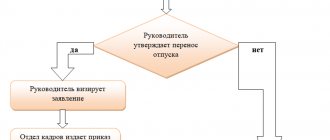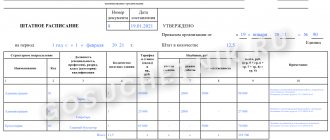Which orders and in which part of them can changes occur?
Almost any orders can be edited, with inaccuracies and violations, wittingly or unwittingly. These could be orders:
- relating to the working conditions of employees;
- some local documents (staffing schedule, vacation schedule, etc.);
- changes of officials;
- relations between employer and subordinates.
As for those parts of the order that can be subject to adjustments, they can also be anything: the basis, main part, conclusion can be edited.
What orders can be changed
The law does not contain direct prohibitions on changing any orders. Thus, any administrative documents in which there are inaccuracies, or due to changes in surrounding circumstances, any part has become irrelevant, must be subject to changes.
These may be the following groups of orders:
- Regarding the working conditions of workers;
- Regarding local regulations issued at the enterprise;
- On the appointment of responsible persons for any actions;
- Regulatory relations between employees and employers;
- Due to personnel changes.
You might be interested in:
Order on approval of the vacation schedule - how to draw it up correctly
You can also make changes to any part of the order itself - you can edit the basis of the document, the main administrative part and the conclusion.
Why make changes
Some employees of organizations neglect to make changes to existing orders, believing that they can do without them. However, this point of view is incorrect, since an order is a document that regulates legal relations in an organization in strict accordance with the law, and therefore has serious legal significance.
The order is mandatory, and if any of its clauses sounds incorrect or erroneous, in the event of disputes and disagreements, it will not be easy to prove the employer is right, which means that both the enterprise as a whole and its management can be brought to administrative liability.
In what cases is a salary change made?
Information about an employee’s salary is one of the important components of the employment agreement.
It should not have double interpretation. In this case, the employee can receive his remuneration for the time actually worked or for the number of units of output. If an employee is paid a salary, this means that if he works a set amount of time every month, he will receive the same amount.
The administration may increase salaries. This occurs when individual legislative acts come into force, or on the initiative of the administration itself, subject to the availability of financial opportunities.
The most common situation for salary changes is when it is set at the minimum wage. As soon as a decision is made at the legislative level to increase this indicator, the administration is also obliged to revise the employee’s earnings upward.
Otherwise, the company will be held liable for failure to comply with the requirements of the law. It is not allowed if, with a typical working day, the employee’s payment will be less than the minimum wage.
In addition, the Constitutional Court is obliged by business entities to index the employee’s earnings annually. The inflation rate, consumer price growth rate, etc. can be used as a coefficient.
Attention: therefore, the salary must be increased by at least the established factor. Commercial organizations can choose the coefficient for themselves independently, budgetary institutions use the approved inflation rate. Business entities can voluntarily, if they have the financial ability, index the earnings of their employees
Business entities can voluntarily, if they have the financial capacity, index the earnings of their employees.
How to make changes: procedure
Changes to the order must be carried out according to a certain algorithm:
- A decision is made that these changes are really necessary and inevitable.
- A special order is issued, which fixes the need to make amendments to an existing document and includes a list of positions that are subject to adjustments.
- The order is signed by the head of the enterprise and responsible employees, and from the date indicated in it, the changes take effect.
Why are changes made to documents?
Typically, orders issued at an enterprise determine the procedure of action necessary under the specified conditions, or establish certain facts.
Moreover, such orders can be either simple, which determine the employer’s relationship with a specific employee, or complex, which determines the interaction of many employees with each other and with the enterprise. The last type of orders include:
- An order to assign the duties of an employee on vacation to other employees;
- Order to conduct an inventory;
- Order on document flow between departments;
- Order to send employees for a medical examination
- and others.
Moreover, due to changed surrounding circumstances, such an order may partially lose its significance or legal force.
However, the general essence of the document remains unchanged. In this case, an order for changes in another order is issued. In the case where, due to changes, the validity of the document is lost entirely, it is best to issue an order to cancel the order.
Important! The law establishes that it is prohibited to enter any changes or make corrections into the text of an already valid document. To make any changes to it, even the most insignificant ones at first glance, you need to issue an appropriate order.
The implementation of one of the following actions is considered as making changes to the administrative document:
- Replacement of words, sentences in any part of the order or appendices to it;
- Exclusion of words or sentences from any part of the order or appendices thereto;
- Exclusion or definition as invalid of any part of the document;
- Addition of any part of the order with words or sentences, introduction of new parts into the document;
- Presentation of the parts available in the order in the new edition.
Who can be trusted to draw up such an order?
The formation of an order to amend the order can be entrusted to any employee of the enterprise who has the necessary powers and has an idea of how to write administrative documents. Most often, this is a person close to the management of the company: a legal adviser, a specialist in the personnel department, a secretary.
However, regardless of who directly draws up the document, he must submit the finished order to the director of the organization for signature - without his autograph, the order will not acquire legal status and can easily be challenged with the help of a labor inspectorate or court.
It should be said that the more carefully and attentively the employee involved in the formation of the order treats his job functions, the less likely it will be for the company’s management to find themselves under the close attention of regulatory authorities.
document
Download as .doc/.pdf Save this document in a convenient format. It's free.
Coat of arms of the JUDICIAL DEPARTMENT AT THE SUPREME COURT OF THE RUSSIAN FEDERATION ————————————————————————— Ex. N _____ ORDER “___” June 1999 N ______ Moscow On introducing changes and additions to the order of the General Director of the Judicial Department dated “___”_________ 1999 N _____ 1. Make the following changes and additions to the order of the General Director of the Judicial Department dated “___ »__________ 1999 N _____: 1.1. The preamble should be stated as follows: “For the purpose of bringing _____________________________________________ ___________________________________________________________________.” 1.2. Enter item 3: “3. Provide the boss with _____________________________________ ___________________________________________________________________.” 1.3. In paragraph 5, replace the words “________________________” with the words “______________________”. 1.4. In paragraph 7, delete the second paragraph. 2. Responsibility for organizing the execution of this order shall be assigned to the manager of the Judicial Department, I.P. Sidorov. General Director initials and surname
Download as .doc/.pdfSave this document now. It will come in handy.
You found what you were looking for?
* By clicking on one of these buttons, you help form a rating of the usefulness of documents. Thank you!
Related documents
- Order: samples (Full list of documents)
- Search for the phrase “Order” throughout the site
- “Sample order for amendments and additions to the order.”doc
Documents that may also interest you:
- Sample order to invalidate orders and instructions
- Sample order to encourage an employee
- Sample order for amendments and additions to the instructions
- Sample order (instruction) on granting additional leave to an employee studying at an educational institution of secondary vocational education in part-time and part-time (evening) forms of study to undergo intermediate certification (Article 174 of the Labor Code of the Russian Federation)
- Sample order (instruction) on additional leave for an employee studying at a state-accredited evening (shift) general education institution to take final exams in grade XI (XII) (Article 176 of the Labor Code of the Russian Federation)
- Sample order (instruction) on granting additional leave to an employee studying at a state-accredited educational institution of primary vocational education (Article 175 of the Labor Code of the Russian Federation)
- Sample order (instruction) on granting additional leave to an employee studying at a state-accredited educational institution of secondary vocational education in correspondence (or full-time and part-time (evening)) forms of study to pass final state exams (Article 174 of the Labor Code of the Russian Federation)
- Sample order (instruction) to provide additional leave without pay to a person caring for children
- Sample order to impose a disciplinary sanction
- Sample order to lift a disciplinary sanction
How to correctly compose and execute an order
There is no unified, single form for an order to amend an order, so it can be drawn up in free form or, if the enterprise has a developed and approved document template, based on its sample.
At the same time, it should be borne in mind that the structure of the form must meet certain office work requirements, and the content must include some necessary information. The latter include:
- Company name;
- place, number, date of drawing up the order;
- rationale and basis for it.
The text must include a reference to the order to which adjustments are made using this order, as well as a complete list of changes (indicating the revision “before” and “after”).
Then the employees responsible for its implementation should be appointed.
Parts of an order
Despite the fact that the paper does not have a clear, prescribed form in the law (it talks about free form of presentation), it is advisable to adhere to the predetermined structure of the order. An official document requires a clerical type of presentation of information.
At the top of the order to change the terms of the employment contract, in the middle, the full name of the company that issues it is always written. Just below is the date and document number. After the word “Order,” the reasons that prompted the leader to issue it are always listed. It could be:
- Conducted certification of working conditions.
- Completion of advanced training courses by the employee.
- Employee statement.
- Injury received by the employee, etc.
After stating the reasons, the document must clearly and point by point record what exactly will change in the terms of the employment contract. This could be time, place, responsibilities, payment, tariff rate, etc.
The order must also indicate:
- Dates from which changes occur. Moreover, for each item of the order the date is written separately.
- The fact of sending a written notification to the employee about the release of the order.
- The personnel officer or other official responsible for communicating changes to the employee. And also which of the company’s employees is obliged to draw up additional agreements to the employment contract so that the changes are recorded there too.
- Who controls the fulfillment of the requirements set out in the document. In most cases, the manager retains control.
At the end of the document, the basis for the changes being made is indicated. This could be an employee statement or any other document. But this paragraph is not a mandatory part of the order.
At the very bottom of the completed sheet is the signature of the head and the seal of the organization. Also, all persons who were mentioned in the text of the order must sign there. For example, HR manager, lawyer, HR officer, etc.
It is advisable to make two or three copies of the order. One of them is sent personally to the employee whose terms of the employment contract are changing. He must sign for its receipt.
In any case, the order number enters the company’s personnel records register. They relate to personnel documents. The shelf life of this document is 75 years.
Requirements for placing an order
The execution of an order, as well as its content, can be completely arbitrary: the document can be printed on a computer or written by hand on company letterhead or on a regular sheet of any convenient format.
Remember! The order must be certified by the “living” signature of the director of the organization or a person authorized to act on his behalf. Also, the order must be signed by the employees responsible for its execution and those whom it directly concerns (in all cases, the use of facsimile autographs is unacceptable).
The need to put a stamp on a document arises only when this norm is enshrined in the internal regulations of the company.
The order to amend the order is drawn up in one original copy, but if necessary, certified copies can be made.
For the entire period of validity, it should be kept in a special folder along with other administrative documentation of the enterprise, and after losing its relevance it should be sent to the archive of the organization, where it should be stored for the period established by the legislation of the Russian Federation or the local legal papers of the organization.
Procedure for issuing an order
The need to make changes to the company structure may arise:
- as a result of the introduction of a new line of activity;
- when attracting new specialists due to modernization of production;
- due to job cuts;
- in connection with an increase or decrease in salaries, etc.
Labor legislation does not establish any special requirements for the timing and procedure for making changes to the company structure. Therefore, these issues are left to the discretion of the manager. If an organization needs to create a new department or other structural unit, then it is advisable to change the staffing table itself. If you need to add a new staffing position, it is quite enough to change the personnel schedule by issuing a corresponding document.
An order to introduce a new position can be developed by order of the head of the organization:
- personnel service;
- lawyers;
- secretary.
When developing such an order it is necessary:
- Analyze general information:
- about job responsibilities;
- about optimal time costs;
- on the hourly standards provided for the corresponding type of work.
- Decide on the acceptable hourly workload (rate, 0.5 or 0.25 rate or less) for a new employee.
- Develop a draft job description.
- Prepare a proposal addressed to management to increase staff. It can be sent on behalf of:
- head of the personnel department;
- the head of the department to which the new unit is proposed.
- Develop an order form.
The memo provides all the statistical data that was obtained to justify the optimality of establishing new positions.
If a new structural unit is introduced into a company department, the memo must be signed by the head of the relevant department.
An internal memo about the need to introduce a new workplace is drawn up by the head (or specialist) of the HR department:
- if the new official will report to the manager;
- if the employee is not related to any structural unit.
An order for the introduction of a new staff unit and detailed instructions describing the responsibilities of the new employee are attached to the memo as an appendix. After the employer approves the proposals set out in the memorandum, he signs an order to introduce a new position into the staffing table.
repeated order or addition?????
The external design is similar to the first example, so we will present only the content of the main part.
Based on the memo from the head of the statistics department dated October 27, 2013 No. 15-56/89
I ORDER:
- Approve and put into effect from 11/01/2013 the attached list of additions to the staffing table, approved by order of Masterok CJSC dated 03/23/2013 No. 21 “On approval of the staffing table”.
- To the head of the HR department P.S. Bystrykin is entrusted with the responsibility for monitoring the proper execution of this order.
We recommend that you draw up the list of updates made to the order as an appendix to the order, for example in the form of a table (exclude/introduce).
Changes to the order are made according to a similar scheme, replacing the word “ORDER” with “ORDER”.
Below is a sample of how to make changes to the order in the event of dismissal or hiring of new employees.
Due to changes in personnel composition at LLC "August"
I OBLIGE:
In clause 1 of the order of LLC “August” dated 02/11/2014 No. 85 “On the provision of social charitable support to children with disabilities”, amend:
exclude M.M. Petrenko from the charity council. and include D.G. Vasiliev in the composition.
Using the samples provided by us in your work, you will significantly simplify the process of drawing up documentation at your enterprise.
Sample Order to amend the Order
Quite often, provisions approved by an order or directive of a manager need to be adjusted - in such a situation, a sample order to change an order is useful.
Editing an old act is sometimes easier than canceling and replacing it with a new one.
We explain the rules by which changes are made to a previously issued order, how often this can be done, and also offer to download standard sample documents.
Rules for drawing up an Order to amend a previously issued Order
An order is a local regulatory act issued by the head of an organization to regulate certain areas of the organization’s work. For example, to approve the staffing table, job description, and composition of the commission. There are quite a lot of issues that are resolved by executive orders.
A situation often arises when previously approved standards become outdated, change and require revision. The manager can go two ways:
- edit the old document - rewrite certain provisions and approve with a new order;
- repeal the unnecessary provisions and issue a relevant order in their place.
The second option seems more logical, but in practice it often turns out that one order contains several provisions, of which only one needs to be changed. In this case, it is not advisable to cancel the entire document and replace it with a new one: it is much easier to make targeted amendments.
If certain provisions of a previously approved order are outdated, you can change them without canceling the document
How to make changes:
- Use the organization's letterhead. It is necessary to indicate the name of the organization, date and address.
- The document is assigned a number in the order of general document flow.
- Name - “Order on amendments to order No.... dated...”. Indicate the number and date of the document being edited.
- The preamble states the reason for the revision. Typically, very formal sentences are used. For example, “in order to bring the company’s staffing schedule in line with modern needs.”
- In capital letters I ORDER.
- All amendments are listed below in separate paragraphs. The paragraph of the old document and its new reading are indicated.
- One edit - one point. This will make the document easier to read and execute.
- If an order is issued on the basis of any document, information about it must be indicated on a separate line. For example, if the document is changed due to the changed surname of the employee mentioned in the old act “Base: copy of the marriage certificate of Ivanova M.V.”
- The act ends with the signature of the manager.
- If the content of a local act suggests that for its entry into force it is necessary to familiarize some employees, make the line “Familiarized”. It's not obligatory.
Thus, editing the document is quite simple. Typically, this work is performed by a clerk (or an employee in a similar position) or a personal assistant to the manager.
The document comes into force from the moment of signing, unless another period is indicated in its text.
The number of changes to one normative act is not limited: in fact, the director can edit orders every day (the only question is how expedient this is).
If there are a lot of changes, you can move them into a separate application
Standard samples of Change Orders
We have found that preparing an order to change another document is quite simple. However, in practice it turns out that it is not the form of the document that causes difficulties, but the wording of the reasons and amendments. The compilers do not know how to correctly indicate why the document is changing or cannot edit the paragraph. Let's look at some of the most common examples.
An order that will record a change in an employee’s salary can be issued using the following wording:
“In order to increase the motivation of sales department employees and bring their remuneration into line with modern market conditions, I order order No. 25 to state paragraph 3 in a new edition: “the salary of a sales department manager is 18 thousand rubles.”
If the act changes the work schedule, the sample could be like this:
“In order to optimize the production process, I order changes to act No. 3-r dated March 21, 2021... paragraph 1 is read in the new edition: “The enterprise establishes a 5-day work week, Monday to Friday, from 10:00 to 19:00 hours with a 45-minute lunch break, the time of which employees choose independently.”
Suppose a manager wants to make changes to the order approving the timing of a business trip.
“In order to approve the new work plan for the deputy head of the sales sector, I order in order No. 321-k dated February 29, 2021, in paragraph 3, the words “for 5 days” to be replaced with “for 5 working days.”
The principle of presenting the amendments is simple: either specific words and expressions are changed, or a completely new wording is proposed. There are no strict rules; in each case you need to choose the optimal and convenient solution.
Download : Order to amend the Order (blank form)
Download: Order to amend the Order (filling sample)
Conclusion
The material presents a sample order for amending an order - a document that is often intended to update a previously approved order.
In some situations, this is more convenient than canceling one document and issuing a new one. There are no restrictions on the number of changes: the same act can be changed any number of times. The document is signed by the head of the organization.
The order comes into force from the moment of signing, unless another period is specified in it.
, please select a piece of text and press Ctrl+Enter.
Procedure for making changes
To make changes to the vacation schedule, you need a documentary basis, which is an order from the manager.
In turn, to draw up an order you also need supporting documents.
The need to change the schedule may arise in the following cases:
- Upon receipt from an employee of an application to postpone vacation in accordance with Article 124 of the Labor Code of the Russian Federation (sick leave during the rest period, going to work and performing government duties, violation by the employer of the rules of the Labor Code of the Russian Federation regarding the provision of annual leave).
- When receiving a request from an employee to change dates due to personal family circumstances.
- Obtaining consent from the employee to postpone vacation dates in response to the employer’s proposal.
All other reasons - family circumstances, production needs - are not strictly obligatory reasons for postponing vacation days.
In order for a personnel employee to make changes to the schedule, he must receive an order from the manager.
In turn, an order is drawn up if there is an application from an employee with a request to postpone or agree to change vacation dates in response to the employer’s proposal.
A sample schedule approval order can be found here.
How to issue orders based on an employee’s application?
If the initiative to change the vacation schedule comes from an employee, then the following circumstances may be the reasons:
- incapacity for work while on vacation;
- temporary call to work during rest to perform duties;
- late payment or non-payment of vacation pay by the employer;
- failure to notify the employee about the start dates of the vacation period - you need to notify 2 weeks in advance;
- family circumstances.
If the basis for the change is the personal circumstances of the employee, then the decision to postpone vacation days and make changes to the schedule is made by the manager at his own discretion.
The first four reasons, when indicated in the employee’s application, are the basis for granting the request and drawing up an order to change vacation dates.
The order to postpone vacation and change the schedule should indicate:
- on what basis is the order drawn up;
- in connection with which the vacation is postponed;
- for what period of time the transfer is carried out;
- an order is given to change the schedule and personnel documentation.
Below you can submit orders for postponing vacation days and making changes to the schedule.
Features of registration at the initiative of the employer
Changing the schedule is possible at the initiative of the employer, but only with the consent of the employee. If the latter does not want to change the dates of his annual vacation, then he has every right to do so, since the vacation schedule is mandatory for everyone.
You can only try to come to an agreement with the employee, indicating the most important reasons for these changes.
Usually the reason is production necessity, which can cover a wide range of reasons. For example, the need to master new equipment, conduct on-the-job training, illness of a partner, or something else.
Before issuing an order to change the schedule at the initiative of the employer, you must send a written proposal to the employee.
In response, the employee writes a statement of consent or refusal.
If consent is formalized, then it is the basis for drawing up an order.
The order form must indicate:
- the reason for postponing the vacation;
- in relation to which employee the changes are being made;
- what is the essence of the changes;
- order to the personnel officer to adjust the schedule.
The order is approved by the director, then the employee gets acquainted with it and signs it. Only after this does it go to the personnel officer, who changes the content of the schedule in accordance with the order of the manager.
Do I need to change the schedule when hiring a new employee?
Mat responsibility is not for everyone
Current legislation limits the possibility of applying swearing liability. Therefore, an agreement on full financial liability cannot be concluded with all employees of the organization. We list the categories of personnel with whom such an agreement can be signed:
- employees directly servicing goods and materials (money) belonging to the employer;
- employees whose positions allow the conclusion of an agreement on mat liability (the List of positions and works was approved by Resolution of the Ministry of Labor of Russia dated December 31, 2002 No. 85);
- employees over 18 years of age.
Collective responsibility
In addition to the individual obligation to compensate for damage from damage (theft) of property, the legislation provides for the possibility of concluding an agreement with staff on full collective (team) responsibility. To conclude such an agreement, the following conditions must be met (Part 1 of Article 245 of the Labor Code of the Russian Federation):
| Collective (team) responsibility | Terms of the agreement |
| Employees perform joint work, for which it is difficult to delimit the personal responsibility of each | |
| Employee positions are included in the list of jobs for which collective responsibility can be introduced (The list of positions and jobs was approved by Resolution of the Ministry of Labor of Russia dated December 31, 2002 No. 85) |









